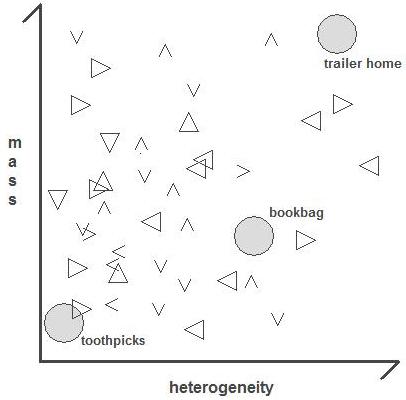
lower left hand corner. For it is a small pile consisting of the same object. Therefore, there are very few objects that could be added successfully to the pile. (By successful we simply mean integrated – is it to be considered a member of the pile tribe? Or is the foreign |
object like a handgun stored in the back of a sock drawer, sharing nothing more that a proximity to the pile itself?) Anything that is neither both small nor of similar composition will fail to integrate. For while a baseball bat, also composed of wood, is similar in regards to composition, and a gummy bear is of comparable size, neither could integrate successfully as a single object. (Of course, if you added enough of either object, the pile would rise on the heterogeneity axis and thus be more accepting of the foreign object in question).
If not already visualized, imagine the 120 or so toothpicks with one gummy bear on top. Now minus the candy and add the 32 inch baseball bat. Both images should seem unnatural, that is less pile-like than before, to you (if not then we applaud your liberal views on pile inclusiveness). If a pile is to grow it should become more cohesive, that is less awkward. Noting the difference between heterogeneity and awkwardness is the point of focus here. Chaotic configurations yes – but piles are always sensible. Think back to natural process of growth, impermanence and migration. Moving on. The second example- the contents of a student's backpack, such as a few books, some pens, a cell phone, and a sack lunch. Such a pile exists higher on both axises of the Mass/ Heterogeneity Scale. than our toothpicks. Thus implying that a wider range of foreign objects could be added successfully, cohesively. A winter hat, although being dissimilar in composition to the |
| previous page | home | next page |